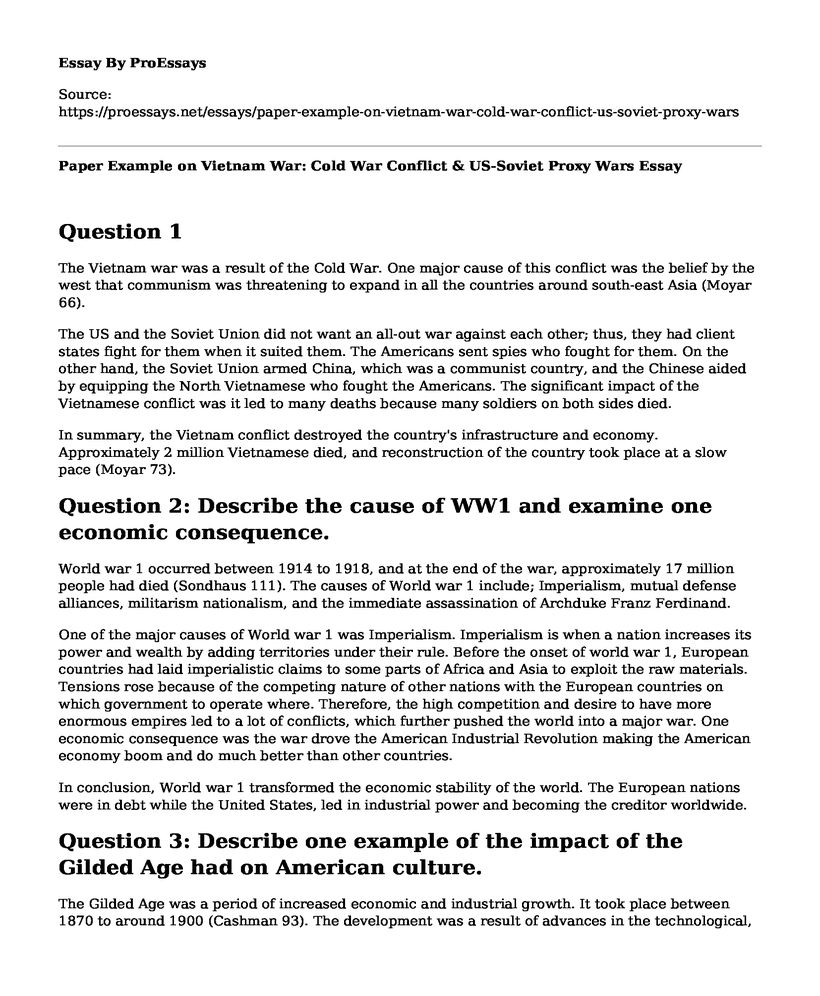Question 1
The Vietnam war was a result of the Cold War. One major cause of this conflict was the belief by the west that communism was threatening to expand in all the countries around south-east Asia (Moyar 66).
The US and the Soviet Union did not want an all-out war against each other; thus, they had client states fight for them when it suited them. The Americans sent spies who fought for them. On the other hand, the Soviet Union armed China, which was a communist country, and the Chinese aided by equipping the North Vietnamese who fought the Americans. The significant impact of the Vietnamese conflict was it led to many deaths because many soldiers on both sides died.
In summary, the Vietnam conflict destroyed the country's infrastructure and economy. Approximately 2 million Vietnamese died, and reconstruction of the country took place at a slow pace (Moyar 73).
Question 2: Describe the cause of WW1 and examine one economic consequence.
World war 1 occurred between 1914 to 1918, and at the end of the war, approximately 17 million people had died (Sondhaus 111). The causes of World war 1 include; Imperialism, mutual defense alliances, militarism nationalism, and the immediate assassination of Archduke Franz Ferdinand.
One of the major causes of World war 1 was Imperialism. Imperialism is when a nation increases its power and wealth by adding territories under their rule. Before the onset of world war 1, European countries had laid imperialistic claims to some parts of Africa and Asia to exploit the raw materials. Tensions rose because of the competing nature of other nations with the European countries on which government to operate where. Therefore, the high competition and desire to have more enormous empires led to a lot of conflicts, which further pushed the world into a major war. One economic consequence was the war drove the American Industrial Revolution making the American economy boom and do much better than other countries.
In conclusion, World war 1 transformed the economic stability of the world. The European nations were in debt while the United States, led in industrial power and becoming the creditor worldwide.
Question 3: Describe one example of the impact of the Gilded Age had on American culture.
The Gilded Age was a period of increased economic and industrial growth. It took place between 1870 to around 1900 (Cashman 93). The development was a result of advances in the technological, manufacturing, and transportation sector.
One example of the impact of the Gilded Age on the American economy was the quick economic advancement, especially in the North and Western part of the US resulted in high wages than those working in Europe; as a result, many skilled workers migrated to the US to seek jobs (Cashman 98).
In summary, the Gilded Age led to many developments, such as emerging public schools and the growth of religious memberships and wealth. Thus, this boosted the American economy and led to the beginning of the Progressive Era.
Works Cited
Moyar, Mark. Triumph Forsaken: The Vietnam War, 1954-1965. Cambridge University Press, 2006.
Sondhaus, Lawrence. World War one: the global revolution. Cambridge University Press, 2011.
Cashman, Sean Dennis. America in the Gilded Age. NYU Press, 1993.
Cite this page
Paper Example on Vietnam War: Cold War Conflict & US-Soviet Proxy Wars. (2023, Jul 24). Retrieved from https://proessays.net/essays/paper-example-on-vietnam-war-cold-war-conflict-us-soviet-proxy-wars
If you are the original author of this essay and no longer wish to have it published on the ProEssays website, please click below to request its removal:
- Biography of John F. Kennedy Paper Example
- Essay Sample on Politics and the Gilded Age
- Biographical Essay on Lenore Tawney
- Diplomacy and War - An Analysis of US Iraq War
- Essay on Comparing the Historical American North and South
- Essay Example on Racism: Historical Legacy of Oppression, Exploitation, and Second-Class Citizenship
- The Neolithic Era and Revolution - Free Paper Example







